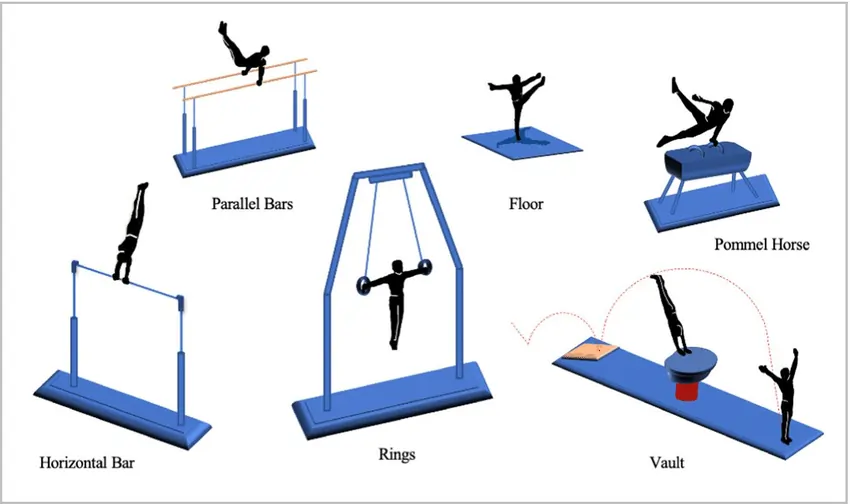Men’s Artistic Gymnastics (MAG) is a riveting sport that combines athleticism with artistry, showcasing the incredible physical abilities and creative talents of male gymnasts. In this comprehensive guide, we delve into the rich history, disciplines, techniques, training methods, competitions, and future prospects of men’s artistic gymnastics. Read More…
Mastering the Art: A Historical Perspective
The origins of men’s artistic gymnastics can be traced back to ancient Greece, where gymnastic exercises were an essential part of military training. Over time, gymnastics evolved into a popular form of physical exercise and entertainment, with competitions becoming a staple of ancient Greek culture. However, it wasn’t until the late 19th and early 20th centuries that men’s artistic gymnastics began to take shape as a modern sport, with the establishment of governing bodies and the development of standardized rules and apparatus.
Mastering the Art: Disciplines and Apparatus
Men’s artistic gymnastics consists of six disciplines, each performed on a specific apparatus:
- Floor Exercise: Gymnasts perform a series of acrobatic and dance elements on a padded floor mat, showcasing their strength, flexibility, and creativity.
- Pommel Horse: Gymnasts demonstrate balance, coordination, and rhythm as they swing and circle around the pommel horse, executing intricate maneuvers with their hands and legs.
- Still Rings: Gymnasts display immense upper body strength and control as they perform dynamic swings, holds, and strength elements on a pair of suspended rings.
- Vault: Gymnasts sprint down a runway before launching themselves over a vaulting table, executing flips, twists, and somersaults with precise landings.
- Parallel Bars: Gymnasts navigate two parallel bars, showcasing strength, fluidity, and precision through swinging, balancing, and transitional movements.
- Horizontal Bar: Gymnasts perform high-flying releases, twists, and swings on a horizontal bar, demonstrating aerial skills and daring maneuvers.
Each discipline requires a unique combination of strength, flexibility, coordination, and artistic expression, making men’s artistic gymnastics a truly diverse and captivating sport. Read More
Mastering the Art: Technique and Training
The mastery of men’s artistic gymnastics demands years of rigorous training and dedication. Gymnasts undergo extensive physical conditioning to develop the strength, flexibility, and endurance necessary to perform high-level skills. Training sessions often include a combination of strength training, flexibility exercises, cardiovascular conditioning, and skill drills tailored to each gymnast’s individual needs.
Technical proficiency is honed through countless repetitions of basic skills and progressions, with a focus on proper form, execution, and technique. Coaches play a crucial role in guiding gymnasts through their training, providing feedback, encouragement, and support to help them reach their full potential.
In addition to physical training, mental preparation is also essential for success in men’s artistic gymnastics. Gymnasts must cultivate mental toughness, focus, and confidence to perform under pressure and overcome challenges during competitions. Visualization techniques, goal setting, and sports psychology strategies are often incorporated into training programs to help gymnasts optimize their performance and achieve their goals.
Mastering the Art: Artistry and Expression
Beyond the technical skills, men’s artistic gymnastics is a form of artistic expression. Gymnasts strive to convey emotion, personality, and narrative through their movements, transcending mere athleticism to create moments of beauty and inspiration. Choreography plays a crucial role in crafting routines that showcase the gymnast’s strengths, style, and personality.
From graceful transitions to powerful displays of strength, each routine is a unique expression of the gymnast’s artistry and interpretation. Music, costumes, and theatrical elements further enhance the performance, creating a captivating and immersive experience for both athletes and spectators alike.
Mastering the Art: The Thrill of Competition
The pinnacle of men’s artistic gymnastics is the competitive arena, where athletes vie for glory on the world stage. Competitions such as the Olympic Games, World Championships, and European Championships serve as platforms for athletes to showcase their talent and compete against the best in the world.
The intensity of competition is palpable, as gymnasts push the boundaries of human performance in pursuit of victory. Moments of triumph and heartbreak unfold as athletes strive for perfection, captivating audiences with their feats of athleticism and artistry.
Mastering the Art: The Evolution of the Sport
Men’s artistic gymnastics continues to evolve, with athletes constantly pushing the boundaries of what is possible. Innovations in technique, equipment, and training methods have revolutionized the sport, enabling gymnasts to perform increasingly complex and daring maneuvers.
The introduction of new disciplines, scoring systems, and judging criteria has also brought fresh dynamics to competition, challenging athletes to adapt and innovate. Despite these changes, the core principles of men’s artistic gymnastics remain unchanged – a celebration of strength, skill, and artistic expression.
In conclusion, men’s artistic gymnastics is a mesmerizing blend of athleticism, artistry, and innovation. From its ancient origins to its modern-day spectacle, MAG continues to captivate audiences with its breathtaking displays of strength, agility, and grace.
Through years of dedicated training and unwavering passion, male gymnasts defy gravity and redefine what is possible in the pursuit of excellence. As we marvel at their extraordinary performances, we are reminded of the limitless potential of the human body and the enduring power of the human spirit.
What are the six disciplines of men’s artistic gymnastics?
The six disciplines are floor exercise, pommel horse, still rings, vault, parallel bars, and horizontal bar.
How do gymnasts demonstrate artistic expression in their routines?
Gymnasts showcase artistic expression through choreography, music selection, fluidity of movement, and emotional interpretation during their routines.
What role do coaches play in the training of men’s artistic gymnasts?
Coaches guide athletes through physical conditioning, skill development, mental preparation, and competition strategies to help them reach their full potential.
What major international competitions do men’s artistic gymnasts compete in?
Men’s artistic gymnasts compete in events such as the Olympic Games, World Championships, European Championships, and various other national and international competitions.
Table of Contents
YOU MAY ALSO LIKE



